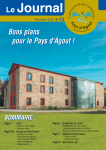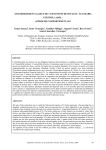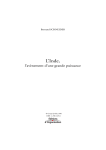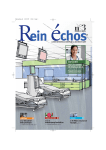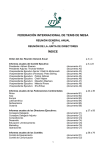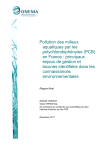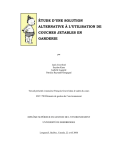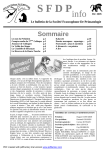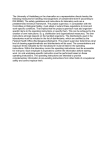Download PDF (2ème partie)
Transcript
ANNEE 2006 THESE : 2006 – TOU 3 – 4003 UTILISATION DES PRIMATES NON HUMAINS EN RECHERCHE BIOMÉDICALE _________________ THESE pour obtenir le grade de DOCTEUR VETERINAIRE DIPLOME D’ETAT présentée et soutenue publiquement en 2006 devant l’Université Paul-Sabatier de Toulouse par Lucile, Eve, Renée WARTER Née, le 2 juin 1979 à STRASBOURG (Bas-Rhin) ___________ Directeur de thèse : Monsieur le Professeur Dominique-Pierre PICAVET ___________ JURY PRESIDENT : M. Patrice MASSIP Professeur à l’Université Paul-Sabatier de TOULOUSE ASSESSEUR : M. Dominique-Pierre PICAVET M. Jacques DUCOS de LAHITTE Professeur à l’Ecole Nationale Vétérinaire de TOULOUSE Professeur à l’Ecole Nationale Vétérinaire de TOULOUSE MEMBRES INVITES : M. Nicolas HERRENSCHMIDT Mlle Fanélie WANERT Mme Annette MARTIN Directeur du Centre de Primatologie de l’Université Louis Pasteur de Strasbourg Docteur Vétérinaire Docteur es Sciences Partie 2/2 154 ANNEXE 4 155 156 ANNEXE 5 157 158 ANNEXE 6 159 ANNEXE 7 160 161 162 163 164 BIBLIOGRAPHIE 1. Aboud E., Suarez C.E., Al-Mefty O., and Yasargil M.G. 2004. New Alternative to Animal Models for Surgical Training. ATLA: 32(Supp.1): pp 501-507. 2. Arévalo-Herrera M., and Herrera S. 2001. Plasmodium vivax malaria vaccine development. Molecular Immunology: 38 (6): pp 443-455. 3. Balls M. 2004. Are Animals Tests Inherently Valid? ATLA: 32(Supp.1): pp 755-758. 4. Bennett B.T., Abee C.R., and Henrickson R.(Eds). 1995. NONHUMAN PRIMATES IN BIOMEDICAL RESEARCH. Biology and Management. Academic Press. 5. Bennett B.T., Abee C.R., and Henrickson R.(Eds). 1995. NONHUMAN PRIMATES IN BIOMEDICAL RESEARCH. Diseases . Academic Press. 6. Bernardi S. Transmission des zoonoses chez les primates. Thèse de Doctorat Vétérinaire. Toulouse, 1998. 7. Blanchet P.J., Konitsiotis S., Mochizuki H., Pluta R., Emerich D.F., Chase T.N., and Mouradian M.M. 2003. Complications of a trophic xenotransplant approach in parkinsonian monkeys. Progress In Neuro-Psychopharmacology and Biological Psychiatry: 27: pp 607-612. 8. Blancho G. 1999. De l’intérêt des primates en transplantation. Primatologie : 2 : pp 381-405. 9. Blewett E.L., Saliki J.T., and Eberle R. 1999. Development of a competitive ELISA for detection of primates infected with monkey B virus (Herpesvirus simiae). J. Virol. Methods: 77: pp 59-67. 10. Blewett L., Black D., and Eberle R. 1996. Characterisation of virus-specific and crossreactive monoclonal antibodies to Herpesvirus simiae (B virus). Journal of General Virology: 77: pp 2787-2793. 165 11. Bons N., Mestre-Francés N., et Petter A. 2000. Microcebus murinus : modèle primate pour l’étude du cerveau de l’homme vieillissant. Primatologie : 3 : pp 3-43. 12. Bontrop R E. 2001. Non-human primates: essential partners in biomedical research. Immunol. Rev. : 183: pp 5-9. 13. Borie D.C., Lam T., Schuurman H., Reitz B.A., et Morris R.E. 2002. Expériences de xénotransplantations porc sur macaque (Macaca fascicularis) à l’Université de Stanford. Primatologie : 5 : pp 169-193. 14. Bourne G.H. (Ed.). 1975. THE RHESUS MONKEY. VOLUME II. Management, Reproduction, and Pathology. Academic Press. 15. Brack M., Rothe H. 1980. Futterungsbedingte “Wasting Disease” bei Weissbuschelaffchen (Callithrix jacchus). Verh Ber Erkrg Zootiere : 22: pp 181-186. 16. Brouillet E, Condé F, Beal M F and Hantraye P. 1999. Replicating Huntington’s disease phenotype in experimental animals. Progress in Neurobiology: 59: pp 427-468. 17. Brugère, Laurent J., Le Bars D., Mahouy G., Milhaud C., Schmitt S., et Wintergerst J. (Eds.). 1992. Expérimentation animale : mode d’emploi. Editions INSERM. 18. Brune K. 2002. Animal experimentation in sciences: sadistic nonsense or indispensable necessity? ALTEX: 19(3): pp 130-6. 19. Brusick D. The Need for Relevant Geriatric Models in Drug Development. 2002. In: Korte R, Vogel F and Weinbauer G F (Eds). PRIMATE MODELS IN PHARMACEUTICAL DRUG DEVELOPMENT, Waxman, Münster, pp 185-189. 20. Bryant C.E., Rupniak N.M., and Iversen S.D. 1988. Effects of different environmental enrichment devices on cage stereotypies and autoaggression in captive cynomolgus monkeys. J. Med. Primatol. : 17 (5): pp 257-69. 166 21. Buchanan-Smith H.M., Shand C., and Morris K. 2002. Cage use and feeding height preferences of captive common marmosets (Callithrix j.jacchus) in two-tier cages. J. Appl. Anim. Welf. Sci. :5(2): pp 139-49. 22. Burbacher T M and Grant K S. 2000. Methods for studying nonhuman primates in neurobehavioral toxicology and teratology.Neurotoxicol. Teratol.: 22 (4): pp 475-486. 23. Buse E, Habermann G, Osterburg I, Korte R, Weinbauer G F. 2003. Reproductive/developmental toxicity and immunotoxicity assessment in the nonhuman primate model. Toxicology: 185 (3): pp 221-227. 24. Butler H. 1974. Evolutionary Trends in Primate Sex Cycles. In: Luckett W.P.(Ed.). Reproductive Biology of the Primates. S. Karger. 25. Byron J.K. and Bodri M.S. 2001. Environmental enrichment for laboratory marmosets. Lab. Anim.: Sep: 30(8): pp 42-8. 26. Cao J, Yang E-B, Su J-J, Li Y, Chow P. 2003. The tree shrews : adjuncts and alternatives to primates as models for biomedical research. J. Med. Primatol. : 32: pp 123-130. 27. Carnaud C., Mahouy G., Maurin-Blanchet H., Marsac J., Schmoll E., et Tambourin P. (Eds). 1995. Le livre blanc sur l’expérimentation animale. Coédition INSERM-CNRS. 28. Chamove A.S., and Anderson J.R. Examining Environmental Enrichment. In: Segal E.F.(Ed). 1989. Housing, Care and Psychological Wellbeing of Captive and Laboratory Primates. NOYES PUBLICATIONS. 29. Chivers D.J and Hladik C.M. 1980. Morphology of the gastrointestinal tract in primates: comparisons with other mammals in relation to diet. J. Morphol. 166 (3): pp 337-86. 30. Code sanitaire pour les animaux terrestre 2003. CHAPITRE 2.10.1. ZOONOSES TRANSMISSIBLES PAR LES PRIMATES NON HUMAINS. 31. Code sanitaire pour les animaux terrestres 2003. Annexe 3.5.1. MESURES DE QUARANTAINE APPLICABLES AUX PRIMATES NON HUMAINS. 167 32. Coecke S., Eskes C., Gartion J., Vliet E.V., Kinsner A., Bogni A., Raimondo L., Parissis N., and Langezaal I. 2002. Metabolism-mediated neurotoxicity: the significance of genetically engineered celle lines and new three-dimensional cell cultures. Altern. Lab. Anim.: 30 (Supp. 2): pp 115-8. 33. Contamin H., Behr C., Mercereau-Puijalon O., and Michel J-C. 2000. Plasmodium falciparum in the squirrel monkey (Saimiri sciureus) : infection of non-splenectomised animals as a model for exploring clinical manifestations of malaria. Microbes and Infection: 2 (8): pp 945-954. 34. Contamin H., Kazanji M., Michel J-C, Mercereau-Puijalon O., et Behr C. 2002. Le singeécureuil (Saimiri sciureus), modèle pour l’étude des réponses immunes à certains pathogènes humains : un potentiel souvent sous-estimé. Primatologie : 5 : pp 335-367. 35. Cropper L.M., Lees D.N., Patt R., Sharp I.R., and Brown D. 1992. Monoclonal antibodies for the identification of herpesvirus simiae (B virus). Arch. Virol.: 123: pp 267-277. 36. De Cabo R., Fürer-Galban S., Anson R.M., Gilman C., Gorospe M., and Lane M.A. 2003. An in vitro model of caloric restriction. Experimental Gerontology: 38: pp 631-639. 37. Dewhurst D. 2004. Computer-based Alternatives to Using Animals in Teaching Physiology and Pharmacology to Undergraduate Students. ATLA: 32(Supp.1): pp 517-520. 38. Dubreuil G., Contamin H., et Dormont D. 2001. Prions et primates non humains. Primatologie : 4 : pp 373-389. 39. Dukelow W.R., and Clemens L.G. 2000. Nonhuman primate in vitro fertilization applications to toxicology. In: Weinbauer G.F., and Korte R. (Eds.). REPRODUCTION IN NONHUMAN PRIMATES. A model system for human reproductive physiology and toxicology. Wawmann. 40. Ebersberger I., Metzler D., Schwarz C., and Pääbo S. 2002. Genomewide Comparison of DNA Sequences between Humans and Chimpanzees. Am. J. Hum. Genet. :70: pp 1490-1497. 168 41. Egan A.F., Fabucci M.E., Saul A., Kaslow D.C., and Miller L.H. 2002. Aotus New World monkeys: model for studying malaria-induced anemia. BLOOD: 99 (10): pp 3863-3866. 42. Elger W. 2000. The role of primate models for reproductive pharmacology. In: Korte R, and Weinbauer G.F.(Eds.). TOWARDS NEW HORIZONS IN PRIMATE TOXICOLOGY. Perspectives for the new millenium.Waxmann. 43. Feger J, Pessigliore M, Francois C, Tremblay L, Hirsch E. 2002. Experimental models of Parkinson’s disease. Ann Pharm Fr.: Jan: 60 (1): pp 3-21. 44. Feitelson M.A., and Larkin J.D. 2001. New Animal Models of Hepatitis B and C. ILAR Journal: 42 (2): pp 127-138. 45. FELASA Working Group on Non-Human Primate Health: H. Weber (Convenor), E. Berge, J. Finch, P. Heidt, F.-J. Kaup, G. Perretta, B. Verschuere, and S. Wolfenson. 1999. Health monitoring of non-human primate colonies. Recommendations of the Federation of European Laboratory Animal Science Associations (FELASA) Working Group on NonHuman Primate Health accepted by the FELASA Board of Management, 21 November 1998. Lab. Anim.: 33 (Suppl. 1): p 18. 46. Fortman J.D., Hewett T.A., and Bennett B.T.(Eds). 2002. The Laboratory NONHUMAN PRIMATE. CRC PRESS. 47. François C., Yelnik J., Faucheux B., Hirsch E., et Agid Y. 1999. Le singe vert, un modèle pour l’étude du tremblement dans la maladie de Parkinson. Primatologie : 2 : pp 357-379. 48. Fraser H.M., and Lunn S.F. 2000. Nonhuman primates and female reproductive medicine. In: Weinbauer G.F., and Korte R. (Eds.). REPRODUCTION IN NONHUMAN PRIMATES. A model system for human reproductive physiology and toxicology. Wawmann. 49. Galat-Luong A (Eds). Directives de la société internationale de primatologie relatives à l’acquisition, aux soins et à l’élevage de primates non humains, édition destinée aux Pays Francophones des IPS Guidelines for the Acquisition, Care and Breeding of Non-human Primates, 1988, Société Internationale de Primatologie. 169 50. Garg R.C. 2000. Primate toxicology: Its role in human pharmaceutical development. In: Korte R, and Weinbauer G.F.(Eds.). TOWARDS NEW HORIZONS IN PRIMATE TOXICOLOGY. Perspectives for the new millenium, Waxmann, pp 223-232. 51. Georges Courbot M-C., et Georges A.J. 2001. Infections à filovirus et poxvirus: des zoonoses transmissibles à l’homme par les primates non humains. Primatologie : 4 : pp 341-358. 52. Gerber P., Schnell C.R., and Anzenberger G. 2002. Behavioral and cardiophysiological responses of common marmosets (Callithrix jacchus) to social and environmental changes. Primates: 43 (3): pp 201-16. 53. Gerding H. 2002. The Role of Primate Research in the Development of Epiretinal Retina Implants. In: Korte R, Vogel F and Weinbauer G F ( Eds ). PRIMATE MODELS IN PHARMACEUTICAL DRUG DEVELOPMENT, Waxman, Münster, pp 149-162. 54. Gerin J.L. 2001. Animal Models of Hepatitis Delta Virus Infection and Disease. ILAR Journal: 42 (2): 103-106. 55. Germain G. 1990. Les primates dans l’étude des mécanismes de la gestation. Path. Biol.: 38(3) : pp 159-165. 56. Gessain A., Meertens L., et Mahieux R. 2001. Origine et diversité génétique du rétrovirus humain HTLV-1 et des rétrovirus simiens apparentés STLV-1. Primatologie : 4 : pp 257-297. 57. Goldsmith E.I. 1969. The current role of non-human primates in surgical research. In: Primates in Medicine: 3: 41-51. Karger. 58. Habenicht U.F. 2000. The cynomolgus monkey as a model for prostate disease: general considerations. In: Weinbauer G.F., and Korte R. (Eds.). REPRODUCTION IN NONHUMAN PRIMATES. A model system for human reproductive physiology and toxicology. Wawmann. 59. Hammond A.C. 1994. Animal Well-Being in Pharmacology and Toxicology Research. J. Anim. Sci. :72: pp 523-527. 170 60. Hart B.A., van Meurs M., Brok H.P.M., Massacesi L., Bauer J., Boon L., Bontrop R.E., and Laman J.D. 2000. A new primate model for multiple sclerosis in the common marmoset. Immunoloy Today: 21 (6): pp 290-297. 61. Hawkins P. 2002. Recognizing and assessing pain, suffering and distress in laboratory animals: a survey of current practice in the UK with recommendations. Lab. Anim.: 36: pp 378-395. 62. Heffernan S., Phippard A., Sinclair A., McLennan S., Hennessy A., Gillin A., Horvath J., Tiller D., Yue D., and Turtle J. 1995. A baboon (Papio hamadryas) model of insulindependent diabetes. J. Med. Primatol. :24: pp 29-34. 63. Herrera S., Perlaza B.L., Bonelo A., Arevalo-Herrera M. 2002. Aotus monkeys : their great value for anti-malaria vaccines and drug testing. International Journal for Parasitology: 32: pp 1625-1635. 64. Hilliard J.K., and Ward J.A. 1999. B-Virus specific-Pathogen-Free Breeding colonies of Macaques (Macaca mulatta): Retrospective Study of seven Years of Testing. Lab. Anim. Sci.: pp 144-148. 65. Howell S., Fritz J., Schwandt M., Malling B., and Miles K. 2001. A community-based occupational enrichment program for captive chimpanzees. Lab.Anim. Sep: 30(8): pp 30-3. 66. Jenner P. 2003. The contribution of the MPTP-treated primate model to the development of new treatment strategies for Parkinson’s disease. Parkinsonism and Related Disorders: 9: pp 131-137. 67. Jerome C P. Osteoporosis and Aging: The Nonhuman Primate Model. In: Korte R, Vogel F and Weinbauer G F ( Eds ). PRIMATE MODELS IN PHARMACEUTICAL DRUG DEVELOPMENT, 2002, Waxman, Münster, pp 85-90. 68. Jones S, Martin R and Pilbeam D( Eds). 1992. Genetic clues of relatedness. In: The Cambridge Encyclopedia of Human Evolution, Cambridge University Press: pp 293-321. 171 69. Kennedy H. Modèle primate et greffe des cellules souches dans le système nerveux. INSERM U 371. Ingénierie biologique au service de la régénération thérapeutique, colloque du 26 avril 2001. 70. Kiesel L and Sonntag B. 2002. Menopause and Hormone Replacement Therapy. In: Korte R, Vogel F and Weinbauer G F ( Eds ). PRIMATE MODELS IN PHARMACEUTICAL DRUG DEVELOPMENT, Waxman, Münster, pp 75-83. 71. King J.E., and Norwood V.R. 1989. Free-environment rooms as alternative housing for squirrel monkeys. In: Segal E.F.(Ed). Housing, Care and Psychological Wellbeing of Captive and Laboratory Primates. NOYES PUBLICATIONS. 72. Kitchen A.M. and Martin A.A. 1996. The effects of cage sizeand complexity on the behaviour of captive common marmosets, Callithrix jacchuc jacchus. Lab. Anim. Oct: 30(4): pp 317-26. 73. Korte R ans All. 2002. Establishment and Perspectives of an Aging Primate Colony for the Study of Geriatric Diseases. In: Korte R, Vogel F and Weinbauer G F ( Eds ). PRIMATE MODELS IN PHARMACEUTICAL DRUG DEVELOPMENT, Waxman, Münster, pp 67-73. 74. Korte R. 2000. The cynomolgus monkey as a model in reproduction toxicology. In: Weinbauer G.F., and Korte R. (Eds.). REPRODUCTION IN NONHUMAN PRIMATES. A model system for human reproductive physiology and toxicology. Wawmann. 75. Korte R., and Stanley M.A. 2000. Primate supply: The past, the present, the future. In: Korte R, and Weinbauer G.F.(Eds.). TOWARDS NEW HORIZONS IN PRIMATE TOXICOLOGY. Perspectives for the new millenium, Waxmann, pp 215- 221. 76. Lacoste V., et Gessain A. 2001. Homologues simiens se l’herpèsvirus humain 8 (HHV8) ou herpès virus associé au Sarcome de Kaposi (KSHV). Primatologie : 4 : pp 323-340. 77. Lane M.A. 2000. Nonhuman primate models in biogerontology. Experimental Gerontology: 35: pp 533-541. 172 78. Lanford R.E., Bigger C., Bassett S., and Klimpel G. 2001. The Chimpanzee Model of Hepatitis C Virus Infections. ILAR Journal: 42 (2): pp 117-126. 79. Lanford R.E., Chavez D., Notvall L., and Brasky K.M. 2003. Comparison of tamarins and marmosets as hosts for GBV-B infections and the effect of immunosuppression on duration of viremia. Virology: 311: pp 72-80. 80. Laroche M.J., et Rousselet F (Eds.). 1990. Les animaux de laboratoire : Ethique et bonnes pratiques. Masson Editeurs. 81. Ling B., Veazey R., Luckay A., Penedo C., Xu K., Lifson J.D., and Marx P.A. 2002. SIVmac pathogenesis in rhesus macaques of Chinese and Indian origin compared with primary HIV infections in humans. AIDS: 16: pp 1489-1496. 82. Lutz C., Wel A., and Novak M. 2003. Stereotypic and self-injurious behavior in rhesus macaques: a survey and retrospective analysis of environment and early experience. Am. J. Primatol. : 60 (1): pp 1-15. 83. MacDonald J., French J.E., Gerson R.J., Goodman J., Inoue T., Jacobs A., Kasper P., Keller D., Lavin A., Long G., McCullough B., Sistare F.D., Storer R., and van der Laan J.W. 2004. The utility of genetically modified mouse assays for identifying human carcinogens: a basic understanding and path forward. The Alternatives to Carcinogenicity Testing Committee ILSI HESI. Toxicol. Sci. : 77(2): pp 188-94. 84. Marvanova M., Ménager J., Bezard E., Bontrop R.E., Pradier L., and Wong G. 2003. Microarray analysis of nonhuman primates : validation of experimental models in neurological disorders. The FASEB Journal: 17: pp 929-931. 85. Maurin-Blanchet H. 2002. A propos d’éthique en expérimentation animale. Primatologie : 5: pp 499-510. 86. McGrew WC, Brennan JA, Russel J. 1986. An artificial “gum tree” for marmosets (Callithrix j. Jacchus). Zoo Biol. 5: pp 45-50. 173 87. MINISTERE DE LA RECHERCHE ET DES NOUVELLES TECHNOLOGIES. Enquête sur l’utilisation d’animaux vertébrés à des fins expérimentales en France, Statistiques 2001. 88. Molzen E.M., and French J.A. The problem of Foraging in Captive Callitrichid Primates: Behavioral Time Budgets and Foraging Skills. In: Segal E.F.(Ed). 1989. Housing, Care and Psychological Wellbeing of Captive and Laboratory Primates. NOYES PUBLICATIONS. 89. Muchmore E.A. 2001. Chimpanzee models for human disease and immunobiology. Immunological Reviews: 183: pp 86-93. 90. Müller-Trutwin M.C., et Barré-Sinoussi F. 1999. Les infections non pathogènes par les virus de l’immunodéficience simienne (SIV) chez leurs hôtes naturels, les singes d’Afrique. Primatologie : 2 : pp 325-356. 91. Müller-Trutwin M.C., Plantier J-C., Diop O.M., Makuwa M., Souquière S., Kornfeld C., Guèye A., Ploquin M., Roques P., Nerrienet E., Barré-Sinoussi F., et Simon F. 2001. Les infections SIV chez les primates et le risque de zoonoses. Primatologie : 4: pp 299-321. 92. National Research Council. 1996. Guide pour les Soins et l’Utilisation des Animaux de Laboratoire, NATIONAL ACADEMY PRESS Washington, D.C. 93. National Research Council. Nutrient Requirements of Nonhuman Primates: Second Revised Edition. 2003. 94. Nguyen Bui X. 2002. Nouvelles approches dans le domaine de la reproduction des primates. Primatologie : 5: pp 109-138. 95. Niggemann B. 2000. Ocular toxicity investigations in primates and options for improvements. In: Korte R, and Weinbauer G.F.(Eds.). TOWARDS NEW HORIZONS IN PRIMATE TOXICOLOGY. Perspectives for the new millenium.Waxmann. 96. Novak M.A., and Drewsen K.H. Enriching the Lives of Captive Primates: Issues and Problems. In: Segal E.F.(Ed). 1989. Housing, Care and Psychological Wellbeing of Captive and Laboratory Primates. NOYES PUBLICATIONS. 174 97. Oiwa Y and All. 2003. Overlesioned hemiparkinsonian non human primate model: correlation between clinical, neurochemical and histochemical changes. Front Biosci.: Sep 1(8): pp 155-66. 98. Ondoa P., Vereecken C., Fransen K., Colebunders R., van der Groen G., Heeney J.L., and Kestens L. 2003. Human and Simian Immunodeficiency Virus-Infected Chimpanzees Do Not Have Increased Intracellular Levels of Chemokines in Contrast to Infected Humans. Journal of Medical Virology: 69: pp 297-305. 99. Partsch C-J, Bee W., Korte R, Sippell W.G., Nieschlag E., and Weinbauer G.F. 2000. Assessment and regulation of bone density in cynomolgus monkeys (Macaca fascicularis). In: Weinbauer G.F., and Korte R. (Eds.). REPRODUCTION IN NONHUMAN PRIMATES. A model system for human reproductive physiology and toxicology. Wawmann. 100. Partsch C-J, Korte R., Schönau E., Schiedermaier U., and Weinbauer G.F. 2000. Developmental changes of bone age and bone density in the purpose-bred male cynomolgus monkey (Macaca fascicularis): Effects of castration. In: Korte R, and Weinbauer G.F.(Eds.). TOWARDS NEW HORIZONS IN PRIMATE TOXICOLOGY. Perspectives for the new millenium.Waxmann. 101. Perrin T. Infection à herpèsvirus B : actualisation des connaissances et proposition d’une prise en charge médicale des accidents d’exposition. Thèse de Doctorat en Médecine, 115p. Strasbourg 1997. 102. Pfister R., Heider K., Illgen B., Belinger R. 1990. Trichospirura leptostoma: a possible cause of wasting disease in the marmoset. Zschr Versuchstierk: 33: pp 157-161. 103. Pietschmann T., and Bartenschlager R. 2003. Tissue culture and animal models for hepatitis C virus. Clin. Liver Dis.: 7: pp 23-43. 104. Preuss T.M. 2004. Specializations of the Human Visual System: The Monkey Model Meets Human Reality. In: Kaas J.H., and Collins C.E. (Eds.). THE PRIMATE VISUAL SYSTEM. CRC PRESS. 175 105. Prince A.M., and Brotman B. 2001. Perspectives on Hepatitis B studies with Chimpanzees. ILAR Journal: 42 (2): pp 85-88. 106. Puget A. et Dubreuil G. 2002. L’éthique en question dans nos relations avec les primates : Comités régionaux d’éthique pour l’expérimentation animale. Primatologie : 5: pp 491-497. 107. Purcell R.H., and Emerson S.U. 2001. Animal Models of Hepatitis A and E. ILAR Journal: 42 (2): pp 161-177. 108. Reinhardt V., Houser D., Cowley D., Eisele S., and Vertein R. 1989. Alternatives to single caging of rhesus monkeys (Macaca mulatta) used in research. Z. Versuchstierkd. : 32(6): pp 275-9. 109. Röder E.L and Timmermans P.J.A. 2002. Housing and care of monkeys and apes in laboratories: adaptation allowing essential species-specific behaviour. Lab Anim. : 36: pp 221-242. 110. Rosenberg Y.J., and Reimann K.A. 2000. Immunophenotypic and functionnal properties of lymphoid cells from nonhuman primates. In: Korte R, and Weinbauer G.F.(Eds.). TOWARDS NEW HORIZONS IN PRIMATE TOXICOLOGY. Perspectives for the new millenium.Waxmann. 111. SaÏb A. 2001. Les virus foamy ou spumavirus : des rétrovirus non-conventionnels. Primatologie : 4 : pp 359-372. 112. Sauer U.G. 2000. Reasons for not using primates in research. ALTEX: 17(4): pp 217-20. 113. Schapiro S.J. 2001. Effects of social manipulations and environmental enrichment on behavior and cell-mediated immune responses in rhesus macaques. Pharmacology, Biochemistry and Behavior: 73: pp 271-278. 114. Schmeel A., and Fibi MR. 1998. Alternative for the neurovirulence test. ALTEX: 15(5): p 22. 176 115. Schmidt L.H. 1969. Selection of species for various uses. In: Primates in Medicine: 2: 28-36. Karger. 116. Schneider B.J. 2001. A study in animal ethics in New Brunswick. Can. Vet. J.: 42(7): pp 540-7. 117. Schnell C. 2002. Intérêt du marmoset en pharmacologie cardiovasculaire : historique et incidences des nouvelles techniques de mesures physiologiques par radio-télémétrie. Primatologie : 5: pp 195-223. 118. Seth S and Seth P K. 1986. A review of evolutionary and genetic differentiation in primates. In: Else J G and Lee P C (Eds). Primate evolution ( volume 1), Cambridge University Press: pp 291-305. 119. Seynave R.L. 2002. Mise en place d’un comité d’éthique. Primatologie : 5: pp 225-242. 120. Shimohama S, Sawada H, Kitamura Y, Taniguchi T. 2003. Disease model: Parkinson’s disease. Trends Mol. Med.: Aug: 9 (8): pp 360-5. 121. Sibal L.R., and Samson K.J. 2001. Nonhuman Primates: A critical Role in Current Disease Research. ILAR Journal: 42 (2): pp 74-84. 122. Snowdon C.T., and Savage A. Psychological Well-Being of Captive Primates: General Consideration and Examples from Callitrichids. In: Segal E.F.(Ed). 1989. Housing, Care and Psychological Wellbeing of Captive and Laboratory Primates. NOYES PUBLICATIONS. 123. Spring S.E., Clifford J.O. and Tomko D.L. 1997. Effect of environmental enrichment devices on behaviors of single- and group-housed squirrel monkeys (Saimiri sciureus). Contemp. Top. Lab. Anim. Sci. May: 36(3): pp 72-5. 124. Sterz H. 2000. Future trends in primate toxicology-Where to go ? In: Korte R, and Weinbauer G.F.(Eds.). TOWARDS NEW HORIZONS IN PRIMATE TOXICOLOGY. Perspectives for the new millenium.Waxmann, pp 205-214. 177 125. Stevens C.E., and Hume I.D. 1995. Comparative Physiology of the Vertebrate Digestive System, 2nd ed. New York: Cambridge University Press. 126. Stowers A., and Miller L.H. 2001. Are trials in New World monkeys on the critical path for blood-stage malaria vaccine development? Trends in Parasitology: 17 (9): pp 415-419. 127. Suzuki J., Miwa N., Kumazaki K., Abe M., Kamanaka Y., Matsubayashi N., Gotoh S., and Matsubayashi K. 2001. The Influence of Rearing Conditions on the Physical Growth of Captive Japanese Macaques (Macaca fuscata). J. Vet. Med. Sci. : 63 (4): pp 361-366. 128. Traeger J. 1969. Transplantations of kidney from chimpanzees to man. In: Primates in Medicine (volume 3), Karger, pp 52-54. 129. Van Akker R., Balls M., Eichberg J.W., Goodal J., Heeney J.L., Osterhaus A.D.M.E., Prince A.M., and Spruit I. 1994. Chipanzees in AIDS research: A biomedical and bioethical perspective.J. Med. Primatol.: 23: pp 49-51. 130. Vandermeersch C.A. Diagnostic différentiel des principales affections rencontrées chez les primates non humains et contrôle des zoonoses. Thèse de Doctorat Vétérinaire 1990 Créteil. 131. Vidal S. La détection des virus de primates avant importation. Intérêt pour la santé humaine, la santé animale, et la qualité des expérimentations. Thèse de Doctorat Vétérinaire. Lyon, 1997. 132. Vogel F. 2000. How to design male fertility investigations in the cynomolgus monkey. In: Korte R, and Weinbauer G.F.(Eds.). TOWARDS NEW HORIZONS IN PRIMATE TOXICOLOGY. Perspectives for the new millenium. Waxmann. 133. Vogel F., and Bee W. 2000. Reproduction toxicology in primates: An overview of methods and techniques. In: Weinbauer G.F., and Korte R. (Eds.). REPRODUCTION IN NONHUMAN PRIMATES. A model system for human reproductive physiology and toxicology. Wawmann. 178 134. Walker L C. 1997. Animal models of cerebral Béta-amyloÏd angiopathy.Brain. Res. Rev.: 25: pp 70-84. 135. Watson S.L., Shively C.A., Kaplan J.R., and Line S.W. 1997. Effects of chronic social separation on cardiovascular disease risk factors in female cynomolgus monkeys. Atherosclerosis: 137: pp 259-266. 136. Weinbauer G.F. 2002. The Nonhuman Primate as a Model in Developmental and Reproductive Toxicology. In: Korte R, Vogel F and Weinbauer G F ( Eds ). PRIMATE MODELS IN PHARMACEUTICAL DRUG DEVELOPMENT, Waxman, Münster, pp 49-63. 137. Wenk G.L. 1993. A primate model of Alzheimer’s disease. Behav. Brain. Res. : Nov 30: 57 (2): pp 117-22. 138. Whiten A., Byrne R. W., Barton R. A., Waterman P.G., and Henzi S.P. Dietary and foraging strategies of baboons. In: Whiten A. and Widdowson E.M. (Eds). 1992. Foraging Strategies and Natural Diet of Monkeys, Apes and Humans. CLARENDON PRESS . OXFORD: pp 187-197. 139. Wijnhoven S.W., and van Steeg H. 2003. Transgenic and knockout mice for DNA repair functions in carcinogenesis and mutagenesis. Toxicology: Nov 15: 193(1-2): pp 171-197. 140. Williams L.E., Abee C.R., Barnes S.R., and Ricker R.B. 1988. Cage design and configuration for an arboreal species of primate. Lab. Anim. Sci. Jun: 38(3): pp 289-91. 141. Zenner L. 2002. Choix et limites des modèles animaux en parasitologie. Sci. Tech. Anim. Lab. : 27 : pp 131-138. 142. Zimmermann Karine. 2001. LE MARMOUSET: ANIMAL D’ELEVAGE ET DE LABORATOIRE. Thèse de Doctorat Vétérinaire, Créteil. 143. Zühlke U., and Mohr S. 2000. Future trends in primate toxicology and refined techniques. In: Korte R, and Weinbauer G.F.(Eds.). TOWARDS NEW HORIZONS IN PRIMATE TOXICOLOGY. Perspectives for the new millenium, Waxmann, pp 233- 241. 179 Toulouse, 2006 NOM : WARTER PRENOM : LUCILE TITRE : UTILISATION DES PRIMATES NON HUMAINS EN RECHERCHE BIOMEDICALE RESUME Les similitudes génétiques, anatomiques et physiologiques qui existent entre l’homme et les primates non humains font de ces animaux des modèles très précieux en recherche biomédicale. Après avoir présenté les différents domaines d’utilisation des primates non humains en recherche biomédicale, l’auteur s’est attaché à effectuer un bilan de l’ensemble des connaissances « pratiques » qu’il a jugé nécessaire d’avoir lors d’utilisation de primates non humains à des fins scientifiques : les contraintes réglementaires et éthiques, les conditions de maintenance en laboratoire, les risques sanitaires liés à la manipulation de ces animaux ou encore les conditions d’approvisionnement en primates non humains en France. MOTS-CLES : PRIMATES NON HUMAINS, RECHERCHE BIOMEDICALE, LABORATOIRE ENGLISH TITLE : THE USE OF NON HUMAN PRIMATES IN BIOMEDICAL RESEARCH ABSTRACT Genetic, anatomical and physiological similarities strongly support the use of non-human primates as animal models in biomedical research. After a description of the main research fields in which non-human primates are employed, the author focuses on major practical hurdles encountered using this animal model in biomedical research. Regulatory and ethical constraints, requirements for the maintenance of these animals in a confined facility, sanitary hazards linked to their handling , as well as the existing supply sources in France, are discussed. KEY-WORDS : NON HUMAN PRIMATES, BIOMEDICAL RESEARCH, LABORATORY





























